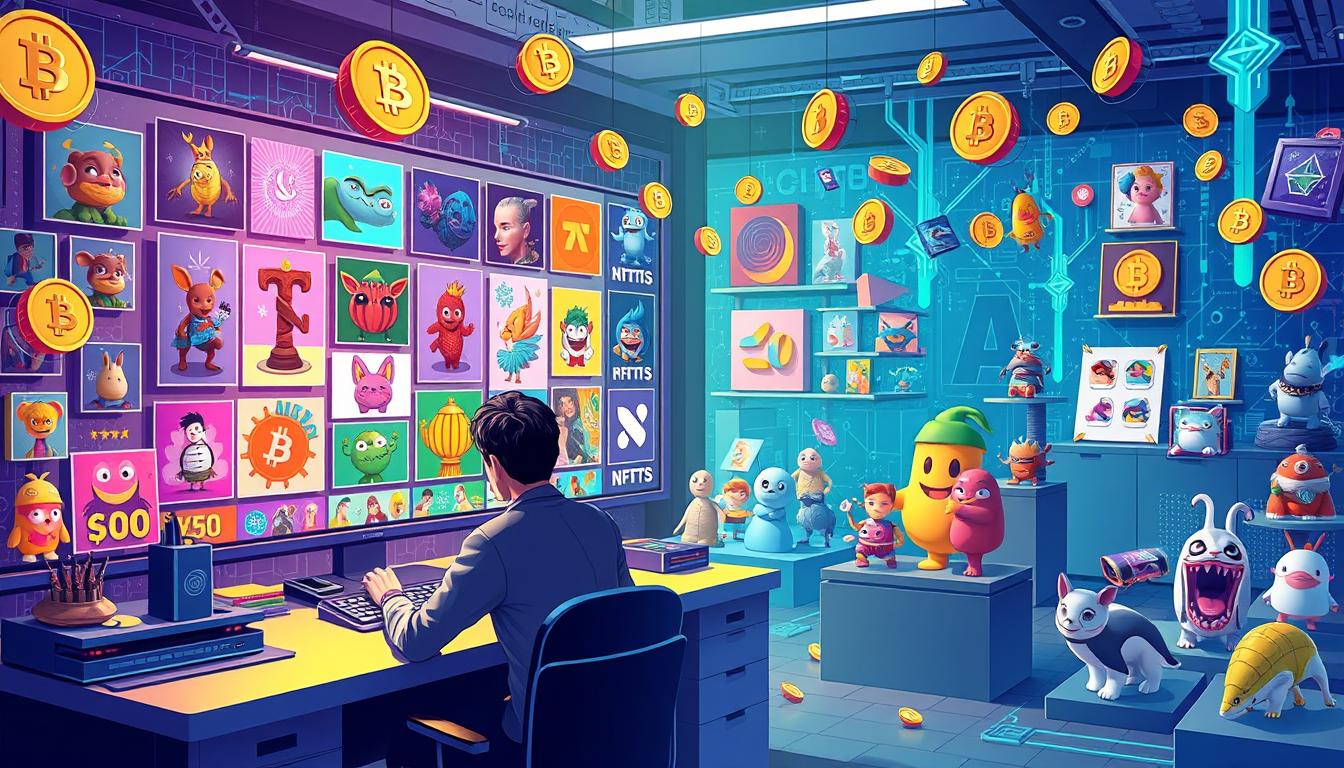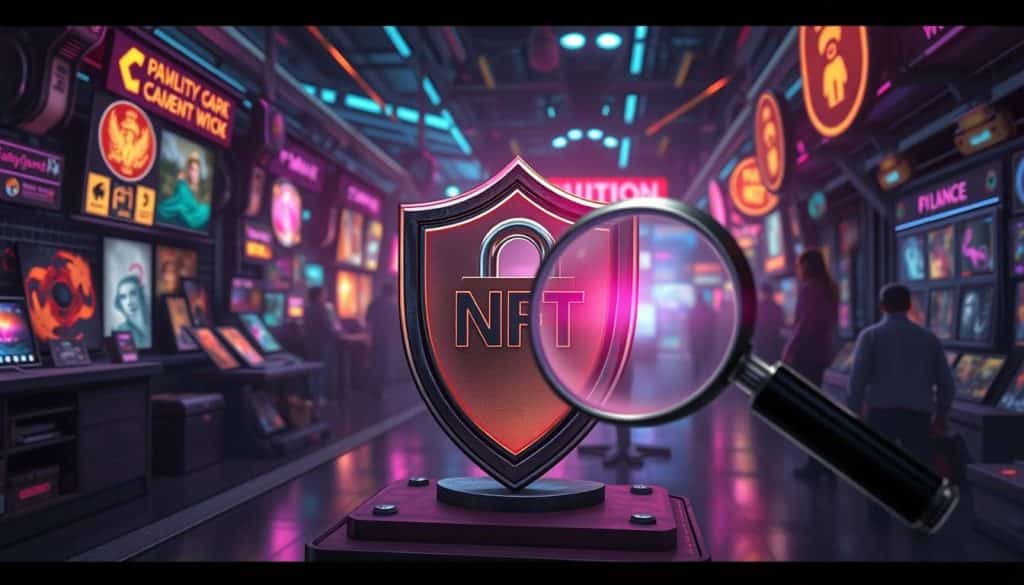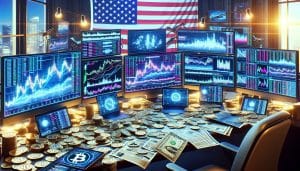Did you know nearly 4% of people in the U.S. owned NFTs by the end of 2022? NFTs are getting lots of buzz, interesting many buyers and fans. These one-of-a-kind digital products can be art, music, or videos1. They offer a new way to own and trade things online1.
At first glance, buying NFTs might seem tough, but it really isn’t. Looking to buy digital art or a special collectible? This full guide on buying NFTs will make it easy. We’ll walk you through setting up a digital wallet, putting money into it, and picking NFT art on well-known sites. Ready to explore how to easily buy NFTs and join the digital wave?
Key Takeaways
- NFTs are unique digital items stored on a blockchain, making them one-of-a-kind.
- Famous NFT sites include OpenSea, SuperRare, Nifty Gateway, and Rarible1.
- OpenSea takes a 2.5% fee on secondary sales, while Binance asks for a simple 1% fee2.
- Investing in NFTs can offer perks like special event access but also carries risks like price changes1.
- NBA Top Shot and NFL All Day offer NFTs with their own fee setups2.
For more on setting up a digital wallet, you might find this guide on starting your trading journey helpful.
What are NFTs?
Non-fungible tokens (NFTs) are changing how we own things digitally. They’re secured with blockchain, giving them a unique ID. This makes them different and more exclusive than other digital assets. The NFT market hit a huge $41 billion in 20213.
Defining Non-Fungible Tokens
A non-fungible token is a one-of-a-kind digital asset on the blockchain. It’s not like Bitcoin or cash, which are all the same. NFTs can be art, music, videos, or even digital land. For example, Beeple’s artwork “EVERYDAYS: The First 5000 Days” sold for a whopping $69.3 million3.
Types of NFTs
NFTs cover many categories and uses. Some common types are:
- Art: Digital art pieces owned, sold, and traded by collectors. Beeple’s works and Charmin’s NFTP are famous examples.
- Sports Collectibles: Unique moments like NBA Top Shot, with a LeBron James highlight selling for over $200,0003.
- Entertainment: Music, movies, and GIFs, including the Nyan Cat GIF, which went for nearly $600,0003.
- Miscellaneous: Items such as Taco Bell’s NFT art and Jack Dorsey’s first tweet, commanding over $2.9 million3.
Why NFTs Are Unique
NFTs stand out because no two are the same. This uniqueness comes from the blockchain, making every NFT special. This ensures that the history of ownership and transfer is clear and unchangeable. NFTs help artists sell their work directly, connect with fans, and keep their rights without middlemen4.
Understanding Blockchain Technology
Blockchain technology is changing how we deal with transactions and manage data. It’s at the heart of NFTs, acting as a decentralized technology. This means it runs transparent and safe transactions in a blockchain network. With a digital ledger, blockchain can list transactions on lots of computers. So, changing the data afterwards is not possible. This feature is crucial for the honesty of NFTs.
In 2017, CryptoKitties came out as the first digital non-fungible tokens (NFTs) you could really own and transfer thanks to Dapper Labs5. NFTs aren’t just digital art and game items. They can be digital ID cards and even land titles5. Unlike things you can swap like dollars, non-fungible things have unique value, like unique baseball cards5. NFTs are made to be safe, one-of-a-kind or rare, and easy to move around5.
Decentralized technology like blockchain makes the market fairer by cutting out middlemen and lowering central power6. Digital artists often struggle with proving they own their work and keeping their rights; blockchain helps by making secure digital proof of ownership6. Also, smart contracts on the blockchain can include royalty payments. This means artists get paid a share when their work is sold6.
Big NFT sales show how the market is growing. In 2023, Kyle Mongraal sold an NFT for $1.6 million, and Larva Labs sold “Crypto Punk #5066” for $1.4 million7. In 2022, Pak’s “Clock” sold for about $53.7 million, showing NFTs’ huge potential within the blockchain network7.
There are hurdles to using NFTs more widely. These include complex technology and concerns about the environment5. Yet, there are eco-friendly solutions like better energy use and Layer 2 networks for faster transactions5. Besides, blockchain can help keep track of carbon emissions accurately6.
How NFTs Work
Non-fungible tokens (NFTs) are based on blockchain technology. This technology offers a clear, unchangeable record of digital ownership8. NFTs can be digital art or virtual property. They got really popular with digital art in 20208. To grasp NFTs, we need to look at ownership, transfers, and smart contracts.
Ownership and Transfer
NFTs show who owns a certain digital item like art or music9. They mainly use the Ethereum blockchain and Ether (ETH) for sales. These are public and easy to check8. NFTs are special because they’re one-of-a-kind. This means they’re not like cryptocurrencies, which can be swapped easily9. Buying an NFT puts your ownership on the blockchain. This makes passing it on smooth and secure.
Using Smart Contracts
Smart contracts help make NFT sales secure and automatic. They put the agreement into computer code9. With these contracts, owning and proving rights to NFTs needs no middlemen9. Ethereum’s good with smart contracts, a big plus for those making or trading NFTs9. Smart contracts simplify things. They manage ownership changes and payments automatically, making things more trustworthy.
Setting Up a Crypto Wallet
If you’re getting into NFTs, it’s key to know why a crypto wallet matters. It’s a secure place for your digital assets. Choosing the right one and keeping it safe are big deals.
Choosing the Right Wallet
Picking a crypto wallet means looking at a few things. First, it has to be safe to keep your digital stuff secure. It should be easy to use for hassle-free buying and selling. And, it must work with different NFT marketplaces.
Popular Wallet Options (MetaMask, Coinbase Wallet)
MetaMask and Coinbase Wallet are big names for handling digital assets. MetaMask is known for working well with Ethereum10. Coinbase Wallet handles Ethereum and Bitcoin, offering flexibility10.
There are about 150 crypto wallets out there, each with unique features11. For top-notch security, gadgets like Trezor Model T and Ledger Nano X store assets offline. They cost $140 to $40012. Hot wallets like Electrum, Exodus, and Mycelium are free and great for easy access and daily use12.
Setting Up and Securing Your Wallet
Once you pick a wallet, setting it up and making it secure is next. Hot wallets are quick to set up, needing just 5 to 10 minutes12. Cold wallets take longer, up to two hours for new users12. Keep your private keys safe to protect your assets.
Hot and cold wallets might have small fees for moving your money. But, storing money in hot wallets usually costs nothing12. Consider a temporary “burner wallet” for short-term deals, especially with NFTs11. Good security practices make NFT trading safer and smoother.
For tips on the legal side of digital assets, check out this useful link.
Funding Your Crypto Wallet
To start buying NFTs, you first need to add funds to your crypto wallet. Most people use Ether (ETH) for this, especially on Ethereum-based sites. You do this by buying cryptocurrency from a trusted exchange. Then, you transfer it to your digital wallet.
Buying Cryptocurrency
Buying cryptocurrency is easy. You do it through big crypto exchanges like Coinbase, Binance, and Kraken. You can use money from your bank, or a debit or credit card to buy it. MetaMask lets you pick from over 90 tokens to buy and works in over 189 countries13. They support many payment methods, including PayPal in the U.S. (but not Hawaii) and Instant ACH. It’s important to pick a well-known exchange. This ensures your money is safe and turned into cryptocurrency without issues.
Transferring Crypto to Your Wallet
After buying the cryptocurrency, you need to move it to your digital wallet. Wallets like MetaMask make this easy. They let you connect, choose how you’re paying, and what token you want. They even show you different prices to pick from13. Make sure to use the right network when transferring—using the wrong one can mean losing your funds. For example, if you’re sending ETH, use the Ethereum network to make sure it arrives.
It’s also smart to double-check transaction info and wallet addresses to avoid mistakes. Adding funds to your digital wallet correctly lets you easily buy NFTs. You can also get into staking and different DeFi (decentralized finance) activities1413.
How to Buy NFTs
To start buying NFTs, look through different NFT marketplaces to pick your platform and NFT. Check out places like OpenSea, Magic Eden, Binance NFT, and SuperRare which all offer various NFT types and fees. For example, OpenSea charges a 2.5% fee for secondary sales. SuperRare asks for 15% from sellers and 3% from buyers15. Meanwhile, Magic Eden and Binance NFT present fixed and more competitive fees respectively2.
Navigating NFT Marketplaces
Choosing the right NFT marketplace can be tricky with so many choices. Pick one that matches your interests and financial targets. For instance, Blur is great for collectible NFTs, whereas SuperRare focuses on premium digital art15. Keep in mind, fees can vary a lot, especially with Ethereum’s gas fees being higher than Solana’s15. Make sure your blockchain wallet has enough money for buying the NFT and covering any fees.
Fixed-Price versus Auction Sales
You have two ways to buy NFTs: fixed-price purchases or auction sales. Fixed-price lets you buy right away at a set price. Auctions mean you bid against others on places like OpenSea2. You’ll find timed auctions that end when the time’s up and Dutch auctions where the price drops over time2. Understanding auction types and fees will guide your buying choices.
Here’s a closer look at some popular NFT marketplaces:
| Marketplace | Focus | Transaction Fees | Blockchain |
|---|---|---|---|
| OpenSea | Collectibles | 2.5% | Ethereum2 |
| Magic Eden | Collectibles | 0% Listing, Variable Transaction | Solana2 |
| Binance NFT | Collectibles | 1%, Additional Fees | Binance Smart Chain2 |
| SuperRare | High-End Digital Art | 15% Seller, 3% Buyer | Ethereum15 |
Completing a Purchase
To buy an NFT, make sure your wallet is ready with enough funds15. Then, follow the steps on the marketplace to buy at a fixed price or win in an auction. Use services like Coinbase, Kraken, or Gemini to get your crypto15. Remember, there are transaction and gas fees, so plan your budget to avoid surprises. After buying, the NFT will move to your wallet, marking the deal complete.
Popular NFT Marketplaces
The NFT market has grown quickly, reaching a value of over $40 billion in 2021, as reported by Chainalysis16. OpenSea, known for charging a 2.5% fee on transactions16, is a favorite among traders. Magic Eden has caught the attention of many for its fresh approach on the Solana blockchain. Another key marketplace is Binance NFT, loved for its low 1% trading fee16.
| Marketplace | Blockchain | Transaction Fee | Unique Features |
|---|---|---|---|
| OpenSea | Ethereum | 2.5% | Gas-fee-free minting17 |
| Magic Eden | Solana | 1.5% | Focus on gaming NFTs |
| Binance NFT | Binance Smart Chain | 1% | Low trading fees16 |
| Rarible | Ethereum | 2.5% | Partnership with Adobe16 |
| SuperRare | Ethereum | 15% first sale, 3% after | High-end digital art17 |
The top NFT platforms are getting popular because of their unique features and fees. From 545,000 wallets in 2020, the number trading NFTs jumped to 28.6 million in 202118. New marketplaces like NFTproX started in 2022, attracting over 120,000 users with advanced blockchain tech for trading various digital assets18. Picking the best marketplace depends on what NFTs you want to trade, the fees, and the blockchain it uses.
Buying Non-Fungible Tokens: Tips and Tricks
Investing in NFTs can be a thrilling but complicated journey. To make the most of your investments and lower risks, it’s important to know tips on investing in NFTs, how to avoid scams, and how to figure out an NFT’s value.
Researching Before Buying
It’s vital to do your homework before investing in NFTs. Start by learning about the NFT’s origin and if it’s real. For example, Jack Dorsey’s first tweet was sold as an NFT for $2.9 million in October 2021. This shows how important the background of an NFT can be19.
Use websites like OpenSea, Rarible, and NBA Top Shot to check out popular NFTs and make sure they’re genuine19. With the right knowledge, you can make choices that fit your investment plans.
Avoiding Scams
Keeping away from scams is key in the NFT world. Always check if the seller is reliable and if the NFT is authentic. Each NFT has a special digital signature, so they can’t be swapped like other assets19.
Look closely at the details on trusted NFT sites like Axie Marketplace and SuperRare. They check everything carefully19. Using safe wallets like MetaMask or Coinbase Wallet for keeping and moving your NFTs adds extra safety.
Evaluating the Value of NFTs
Figuring out the value of an NFT can change a lot and depends on many things. Look at the artist’s fame, how rare the NFT is, and its history. Beeple’s work, “EVERYDAYS: The First 5000 Days,” sold for $69.3 million at Christie’s, showing prices can get very high19.
Ethereum is often used to buy and sell NFTs, which is something else to think about19. Compare prices of similar NFTs and watch the market to make good buying choices.
For more help on buying NFTs, including how to set up a crypto wallet, read this guide on purchasing NFTs19.
What to Do After Buying an NFT
After buying an NFT, the first thing to do is secure it. Digital assets, like NFTs, need strong storage solutions. Most people use a crypto wallet with top-notch security to keep their NFTs safe.
Storing Your NFTs Safely
Keeping your NFT safe is crucial. People often pick MetaMask or Coinbase Wallet for their top security. Putting your NFTs in one of these wallets protects them from hackers and keeps their value safe.
Displaying and Using Your NFTs
Owning an NFT is fun because you can show and use it. Owners can make cool, animated videos of their digital items with Aquifer20. This makes their NFTs stand out on social media and video sites20. Fun fact: 23% of millennials in the US have NFTs and are active in the community. This shows more people are getting into digital assets21.
About 250,000 people trade NFTs monthly on sites like OpenSea. This shows the NFT market is really active21. Keeping your NFTs safe and showing them off in cool ways helps make them more popular and valuable.
For more tips on what to do after getting an NFT, including the latest trends and how to be part of the community, check out this comprehensive guide20.
The Benefits of Buying NFTs
Investing in NFTs has many benefits, especially as the digital world grows. Owning NFTs means you have special digital items that are truly yours. These NFTs prove who owns them, which helps fight fakes in places like the fashion industry22.
The possibilities with digital assets in NFTs are huge. In 2022, people spent over $24 billion on NFT platforms. This shows a big chance for investors to get into digital items that stand out for being rare and real22.
NFTs can’t be split up, which keeps each one unique23. They mainly use the Ethereum blockchain, adding trust and clear details23. What’s more, NFTs are easy to sell due to their popularity, found on sites like OpenSea and Rarible23.
For creators, NFTs are a way to earn from their work through smart contracts23. These contracts ensure the digital items are one-of-a-kind. NFTs attract everyone from big investors to those just starting out22.
Special items, like the Kings of Leon’s “Golden Eye” NFT, offer perks like front-row concert seats24. Owning such tokens gives special access to products and events, and even profits from selling them later on24.
With the NFT market’s ups and downs, it’s key to stay informed and research well22. The NFT world keeps growing and changing, offering big chances for both creative people and investors. This makes NFTs a major area to watch in the digital economy.
NFTs as an Investment
NFTs are becoming popular because they’re unique and can bring high returns. But, just like any asset, investing in NFTs comes with risks. You should think carefully before investing.
Potential for Growth
The NFT market is booming, hitting over $10 billion in sales in just three months of 2021. This shows how active the market is and the potential for big returns for investors25. The first NFT, Quantum, sold for more than $1 million in 2014. This highlights how valuable digital assets can be25.
Every day, loads of NFTs are sold for games, collecting, and more, according to OpenSea. This shows there’s a steady demand26. Marketplaces like OpenSea and Nifty Gateway help sell NFTs in art, gaming, and sports25. All these points suggest NFTs could be a great investment if you’re ready for this fast-moving space.
Risk Factors
Even with their growth potential, NFTs have risks. Their prices can change a lot quickly, making them speculative25. The NFT market isn’t well-regulated. This means there’s not much protection for consumers, and fraud is more possible26.
Problems like market manipulation and speculative hype can cause prices to skyrocket. This could lead to market bubbles26. The evolving NFT market also brings the risk of scams or projects not meeting their promises25. Considering these risks is key before investing in NFTs.
To understand the balance between rewards and risks, check out this table:
| Factor | Details |
|---|---|
| Market Growth | Sales exceeded $10 billion in Q3 202125 |
| Volatility | Highly speculative with potential fluctuations in value25 |
| Regulation | Unregulated market with little consumer protection26 |
| Security | Self-managed with complex storage and transaction processes26 |
| Demand | High demand with hundreds of thousands of NFTs sold daily26 |
In conclusion, NFTs offer great growth potential as investments. But, it’s important to do your homework and think carefully because of the investment risks.
Where to Buy NFTs
Buying digital collectibles is now easier, thanks to many specialized marketplaces. OpenSea, started in December 2017, is the biggest on the Ethereum network. It handles over half of all NFT trades with more than a million users2728. OpenSea supports various blockchains like Ethereum, Solana, and Polygon. This gives buyers a lot of options27.
For Solana fans, Magic Eden is the top choice. It started in September 2021 and quickly became Solana’s lead marketplace28. Another platform, Rarible, opened in early 2020. It grew fast by launching its own token, RARI28.
Foundation is notable for hosting sales of famous digital pieces, like Nyan Cat. It attracts high-profile creators such as Pussy Riot’s Nadya Tolokonnikova and Edward Snowden27. SuperRare highlights single-edition digital artwork. It offers unique pieces for collectors and artists27. Mintable is also worth mentioning. It gives creators and buyers options for “gasless” NFT minting and traditional sales27.
Axie Infinity’s marketplace is all about NFTs for the Pokémon-inspired game. Decentraland allows users to buy and sell virtual land on its Ethereum marketplace27. Magic Eden is crucial for the secondary trading of NFTs on certain blockchains27.
Platforms like Crypto.com and NBA Top Shot are easy for new buyers. They’re known for simple interfaces and following regulations27. On the other hand, LooksRare and Zora give users more control and lower fees. Zora even supports a wide range of NFTs, like music and GIFs, helping artists to earn more27.
Binance and Coinbase are big names in crypto that have entered the NFT world. Binance started in June 2021 and has featured celebrity NFT drops. Coinbase allows the purchase of NFT art with Ether28.
Understanding Gas Fees and Transaction Costs
In the world of blockchain and NFTs, it’s crucial to understand gas fees and transaction costs. These costs are especially high on networks like Ethereum. They greatly affect the total cost of making, buying, and selling tokens.
What are Gas Fees?
Gas fees are the fees paid to cover the computing work needed to handle and validate transactions on the Ethereum network. These fees can skyrocket, sometimes costing thousands of dollars for a single NFT purchase during busy times29. For instance, during the Otherdeeds land sale, users paid about 2.26 ETH (or roughly $6,200) for just two plots because of high gas fees30. Understanding these fees helps users plan their transactions better.
How to Calculate Transaction Costs
Figuring out the total cost of blockchain transactions involves several key parts. First, think about the gas fees, which change based on how busy the network is and the complexity of the transaction. For instance, making an NFT on Ethereum can cost between $100 and $500 in smart contract fees29.
Also, sellers might have to give a 10% to 30% royalty to the marketplace where they sell their NFT29. Besides gas fees, wallets might charge up to 1.50% of the total value for converting fiat to crypto29. Also, Ethereum network fees can go above normal rates during high demand, making things even more expensive30.
Conclusion
Jumping into NFTs might seem complex at first. But if you follow this guide closely, you’ll find it gets simpler. Learn the basics of blockchain technology. Then set up and fund a crypto wallet. Every step is important for a smooth experience in buying NFTs. Most NFT marketplaces use the Ethereum blockchain. This means you’ll need a crypto wallet for transactions31.
Your choice of wallet matters a lot. It affects how you keep and protect your digital assets31. To take part in NFT marketplaces, you have to understand their rules. This includes how to make offers or buy directly31. By the end of 2022, about 4% of people in the U.S. had NFTs. The cost of NFTs varies widely, from a few cents to lots of money32.
For newbies, using popular crypto wallets like MetaMask is a good start32. With this info, you’re ready to explore NFTs. Know the ups and downs. By keeping up to date and cautious, shopping for NFTs can be fun and rewarding.









